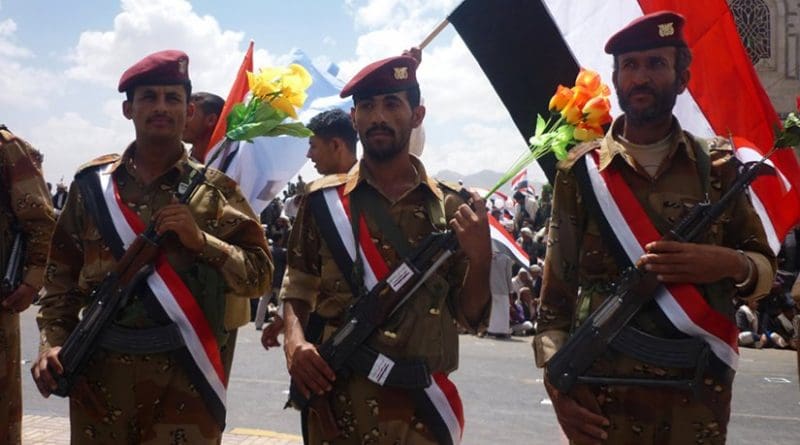Yemen: Militants’ Aggression Against Civilians Gives Weight To Coalition Blockade – OpEd
The Saudi-led coalition has been at war with Houthi since March 2015, when the Houthi militants forced the internationally recognized government of President Abed Rabbo Mansour Hadi into exile. Saudi-led coalition had started the military campaign in order to restore the Hadi government.
From then onwards, Houthi had fired dozens of missiles across the border into the border towns inside Saudi Arabia, causing casualties among local residents. More recently, the militants have taken the assault on Saudi Arabia one step forward by firing two ballistic missiles – in two successive months – right at the capital of Saudi Arabia.
The Houthi militants, who enjoy the backing of Saudi Arabia’s regional foe Iran, fired a ballistic missile, the Burkan-2, at the King Khaled Airport in Riyadh on November 4. The missile, which posed an imminent threat to the civilians in and around the airport, was fortunately intercepted by Saudi Air Defence Forces.
On December 14, the US Ambassador to the UN, Nikki Haley, presented “concrete evidence” of Iran’s involvement behind the missile attack aimed at the civilian populated area in Riyadh. She stood in front of a short-range ballistic missile, which she said was an Iranian-made missile sent to the Houthi militants, who later fired it at Riyadh on November 4.
After the Houthi militants fired the Burkan-2 missile at Riyadh’s airport, the Saudi-led coalition tightened its blockade on the Yemeni territories held by the Houthi militants in response to the attack, saying the coalition wanted to halt the smuggling of weapons from Iran.
In early-December, the Houthi militants claimed that they fired a missile at an under-construction nuclear plant in the United Arab Emirates (UAE), which is part of the Saudi-led coalition battling the militant group in Yemen. The UAE, however, denied the claim.
When the coalition tightened the blockade following November 4 missile attack, the UN warned that the restrictions could trigger “the largest famine the world has seen for many decades”. The coalition later eased its restrictions marginally, allowing humanitarian aid to be delivered to Houthi-controlled ports and airports.
Despite the gesture shown from a humanitarian angle, Saudi Arabia once again was attacked with another missile from beyond its borders. Houthi militants fired a ballistic missile at Riyadh on December 19, making it their second effort to fire missiles at civilian populated area in Riyadh.
Indeed, Saudi-led coalition’s spokesperson said that the latest missile was directed indiscriminately towards civilian and populated areas in the south of Riyadh, though the missile had been intercepted by a US-made Patriot missile before it could cause any casualty to any civilians.
However, the main Houthi spokesperson said that the missile was fired towards a meeting of the Saudi leadership at the Al-Yamama Royal Palace in Riyadh to mark the 1000 days of the ongoing Yemen war. The meeting was expected to be attended by, among other, the Crown Prince Mohammed-bin-Salman.
Following the missile attack on December 19 – Anwar Gargash, minister of state for foreign affairs of the UAE – tweeted that the necessity of military operation against the Houthi becomes clear with every Iranian-missile fired by the Houthi militants against civilian targets.
The latest missile attack on December 19 could compel the Saudi-led coalition to tighten the blockade once again. After the attack, already the coalition’s spokesperson accused the Houthi militants of using humanitarian entry points to import missiles from Iran.
Though blockade causes shortages of essential non-military supplies, lifting it ensures the Houthi militants get more missiles to fire at the population centres in the Gulf States, killing many civilians each time if missile-interception attempt fails.
Therefore, despite the sharp UN warnings that the Saudi-led coalition’s blockade on Yemen could trigger the largest famine the world has seen for many decades, Houthi’s missile attacks to Riyadh’s populated airport and residential area give some credence to the blockade. Easing the blockade primarily helps smuggling of weapons, including missiles from Iran, into Houthi-held Yemeni territories.
Re-examining whom to blame for humanitarian crisis
Though a number of media outlets and foreign ministries of European countries have put the ‘primary’ blame on the Saudi-led coalition’s actions for the humanitarian crisis in Yemen, there should be a re-examination as to whether the coalition is primarily responsible for such crisis.
Had the Houthi militants not targeted Riyadh’s civilian populated airport and residential area and the bordering areas between Saudi-Yemen borders, there would have been no necessity for the coalition to tighten the blockade.
More importantly, had the Houthi not occupied the capital of an independent state (Sanaa in Yemen), there would have been no justification – at the first place – for the coalition to wage a war to restore an internationally recognised government of Yemeni President Mansour Hadi.

